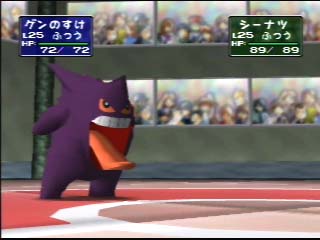






Publisher: Nintendo Origin: Japan Developer: Nintendo Genre: Simulation Release: Out in Japan, Quater 1 release in USA
MSRP: 5800 yen ($55) One of three Pokemon games in development for the N64, Pokemon Stadium is a unique, but rather strange addition to the growing franchise.
Remember those turn-based battles in most of the popular role-playing games like Final Fantasy? Two (or more) creatures or humans square off against each other, enabling the player to input attack commands and watch the battle. Pokemon Stadium instantly reminds you of those RPGs.
The premise behind this type of game genre, popularized by Pokemon for the Game Boy and Monster Ranchers for the PlayStation, is not story or action. "Collection" and "training" are the key words.
The game features 40 built-in creatures that you can build up and train for battle.
The Japanese version of Pokemon Stadium is set
to ship with an included 64GB Pak This device plugs into your controller's memory card slot, similar to the
Rumble Pak. If you happen to be the owner of one of the Game Boy Pokemon
games, plug that Game Boy cart into the 64GB Pak, switch on Pokemon Stadium,
and swap data between the two games. This way, you can bring the monsters
you have discovered in the Game Boy Pokemon into the N64 game and view
them in their 3D color glory.
This device plugs into your controller's memory card slot, similar to the
Rumble Pak. If you happen to be the owner of one of the Game Boy Pokemon
games, plug that Game Boy cart into the 64GB Pak, switch on Pokemon Stadium,
and swap data between the two games. This way, you can bring the monsters
you have discovered in the Game Boy Pokemon into the N64 game and view
them in their 3D color glory.
Starting up Pocket Monsters Stadium brings you to a menu screen sporting eight options:
Computer (Pasokon): There are four boxes with 30 slots each on the Game Boy Pokemon cartridge, so you can save the details of 120 monsters. Since that's not nearly enough memory to store all your horde, this option allows you to transfer the info onto the cartridge itself.
Picture Book (Zukan): Allows the creation of an electronic "photo album" of your collection, categorizing the monsters according to the 151 different species. You can then view them in all their animated 3D polygon glory. The picture book mode also includes maps that show the exact locations and habitats of your monsters.
Quick Look (Ichiran): For a rapid review of your collection, this option lists the monster name, type, number, techniques, and other stats. It also shows which items are stored in the computer (on the cart), so you can employ the "Use" tool to quickly select the monster you wish to put into combat.
GB (Game Boy): This function enables you to play the Game Boy Pocket Monsters game via the N64 (using the machine's controllers) on your TV screen.
Collection (Temochi): This is a database of all the monsters. Players can check out the attributes of their brood, as well as size up the opposition, and discover which attacks may be used against them in the upcoming battle.
Registration (Touroku): Import your friends' monsters and fight them as many times as you want.
Tournament (Stadium): Send your monsters into battle against computer-controlled monsters or your friends' creatures.
When you prepare your monsters for combat, assign specific moves to the C-Buttons and then trigger the attacks and defenses during battle. The monsters then enter a ring and battle each other in smooth, polygonal 3D. As you can see, the general monster designs are traditionally Japanese-cute style. However, once these guys show off their fire, lightning or rock attacks, you gain new levels of appreciation (or fear) for your little monsters.
It remains to be seen whether Pokemon Stadium will be released in the US. The recent release of the game in Japan has put the game on the top of the Japanese charts. Nintendo even delayed the release of the game to prevent children from skipping school to purchase it. If pokemon is a hit in the US Nintendo will probably release the game during the Christmas season along with Zelda 64. (Screen shots at left)thanks to ign64 for the photos